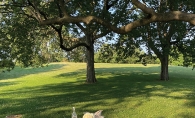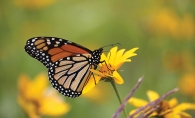They’re the bursts of color that catch your eye as you go 60 miles per hour along Highway 94, and the intricate clusters of blooms you see protruding from stems along Maple Grove walking paths. You see them every year and you can count on their friendly faces meeting you at different times in the season as the weather heats up. Meet six very special flowering native plants. This summer you’ll be on a first-name basis!
Butterfly weed (Asclepias tuberosa var. interior)
You could rename this one Butterfly Magnet. The yellow-orange to bright orange flat-topped flower clusters, measuring 2 to 5 inches across, are at the top of a flowering stalk. The abundance of stiff, lance-shaped foliage on a hairy stem provides a dark-green backdrop for the showy flower heads. Lepidoptera, which include moths and butterflies, can’t resist it. It grows as tall as two- and- a- half feet, multiplying in numerous stems that grow denser each year. It also has a very long taproot and can be hard to get rid of once it has established itself. However, its hardiness was appreciated by Native Americans, who chewed the root as a cure for pleurisy and other pulmonary ailments.
Swamp Milkweed (Asclepias incarnata alba)
Loaded with fragrant, attractive pink flowers, it is happy growing wild near the edges of ponds and streams. It’s is a favorite of Monarch butterflies. If you see one fluttering around, take a brief look on the underside of the leaves and you’re likely to find an egg or two. The emerging caterpillars feed on the leaves.
Tall Blazing Star (Liatris pycnostachya)
“Liatrus species are an excellent nectar plant for many butterflies,” say Vicky Wachtler, naturalist at Eastman Nature Center.Tall Blazing Star grows to four feet high. The flowers are an erect spike with numerous purple stalkless flower heads blooming from the top down. You’ll see it later in the season as it flowers from mid-August through September. You can imagine these stately stems rising above the tallgrass prairies of the original American landscape. Tall Blazing Star was one of the many plants Lewis and Clark recorded on their transcontinental journey in the early 1800s, at the behest of Thomas Jefferson.
Wild Bergamot (Monarda fistulosa)
You may know this one by its common name: bee balm. “Bergamot is in the mint family, and it is a plant that is used in teas. Also, since it is a mint, it has a square stem,” Wachtler says. It occurs in clusters of 20 to 50 flowers, and is noted for its fragrance and for being a source of thyme oil, a dietary supplement and antioxidant. Today, wild bergamot is used during the cold and flu season as an immune system booster.
Common Yarrow (Achillea millefolium)
You might call this one an “adopted” native. “Yarrow originally came from Europe [and Asia]. It is now a common plant seen in fields and along roadsides,” says Wachtler. Though some folks think of it as a weed, it’s considered an especially useful plant by naturalists because it repels insect pests. It’s also helpful to humans: Its leaves encourage blood-clotting, thus the nicknames “nosebleed plant” and “soldier’s woundwort.” Yarrow was also popular as a vegetable in the 17th century. The younger leaves were cooked like spinach. They are sweet with a slightly bitter taste. So, if you become injured, or hopelessly lost without a granola bar during a long hike, it could just be a lifesaver.
Black-eyed Susan (Rudbeckia hirta)
You might guess that this one is a member of the sunflower family. The flower heads are 2 to 3 inches wide, and the plant usually grows 1 to 3 feet tall. They blanket entire fields and can be breathtaking upon discovery when rounding a bend. Black-eyed Susan is probably the most popular native flower in North America. But while we might love to look at them—and they’re a favorite food source for aphids, slugs, rabbits and deer—they are also toxic to cats when ingested.









